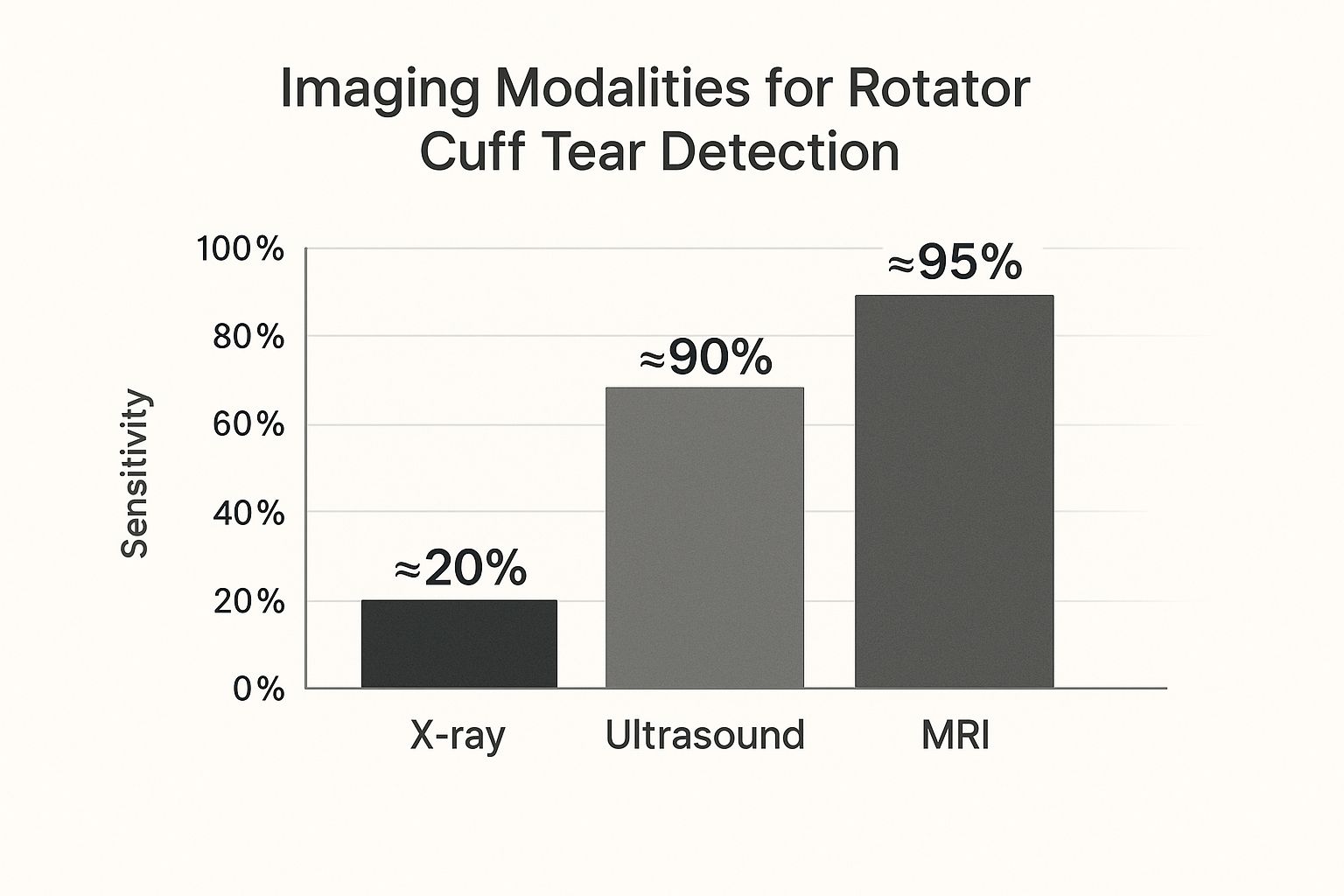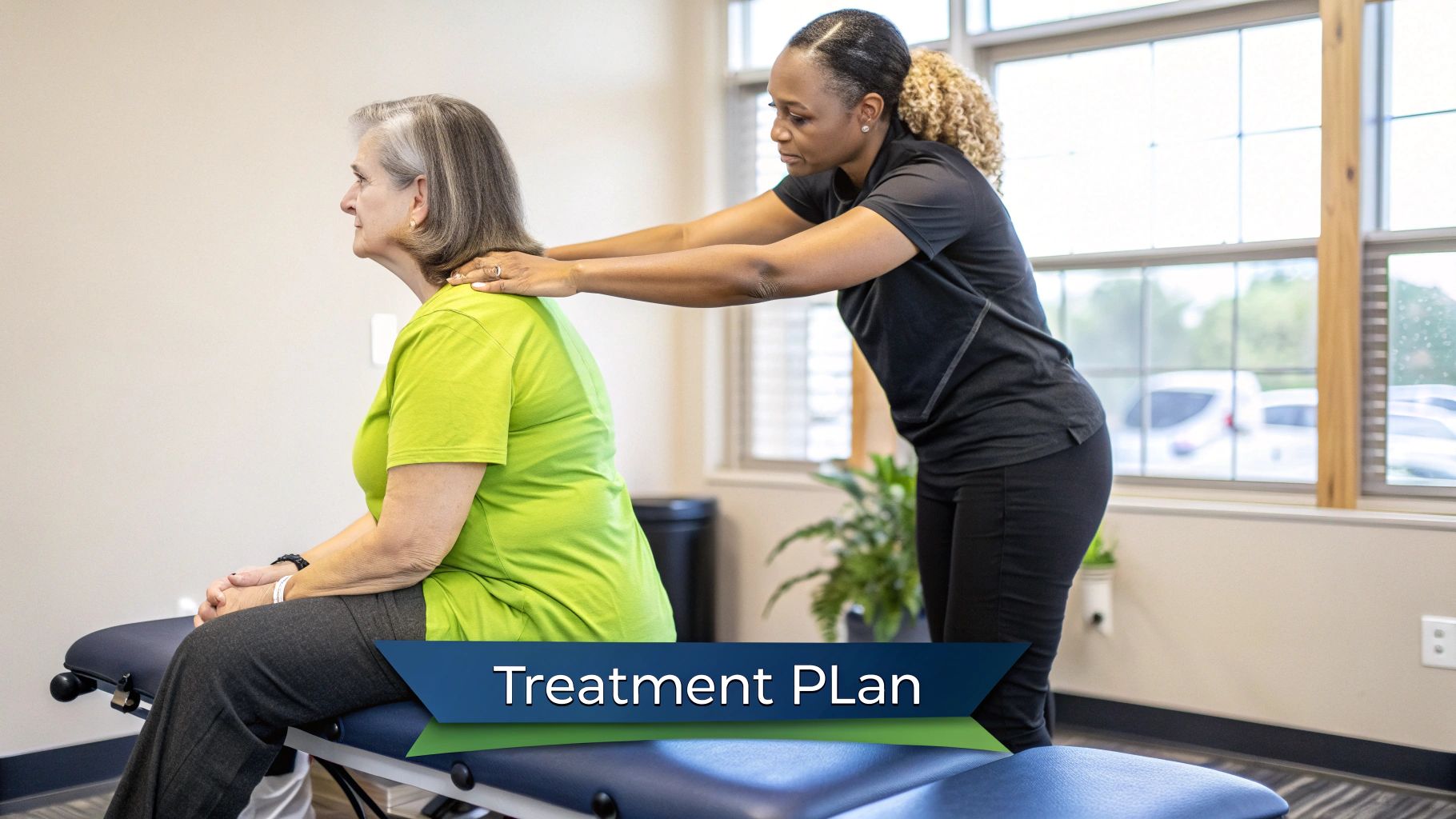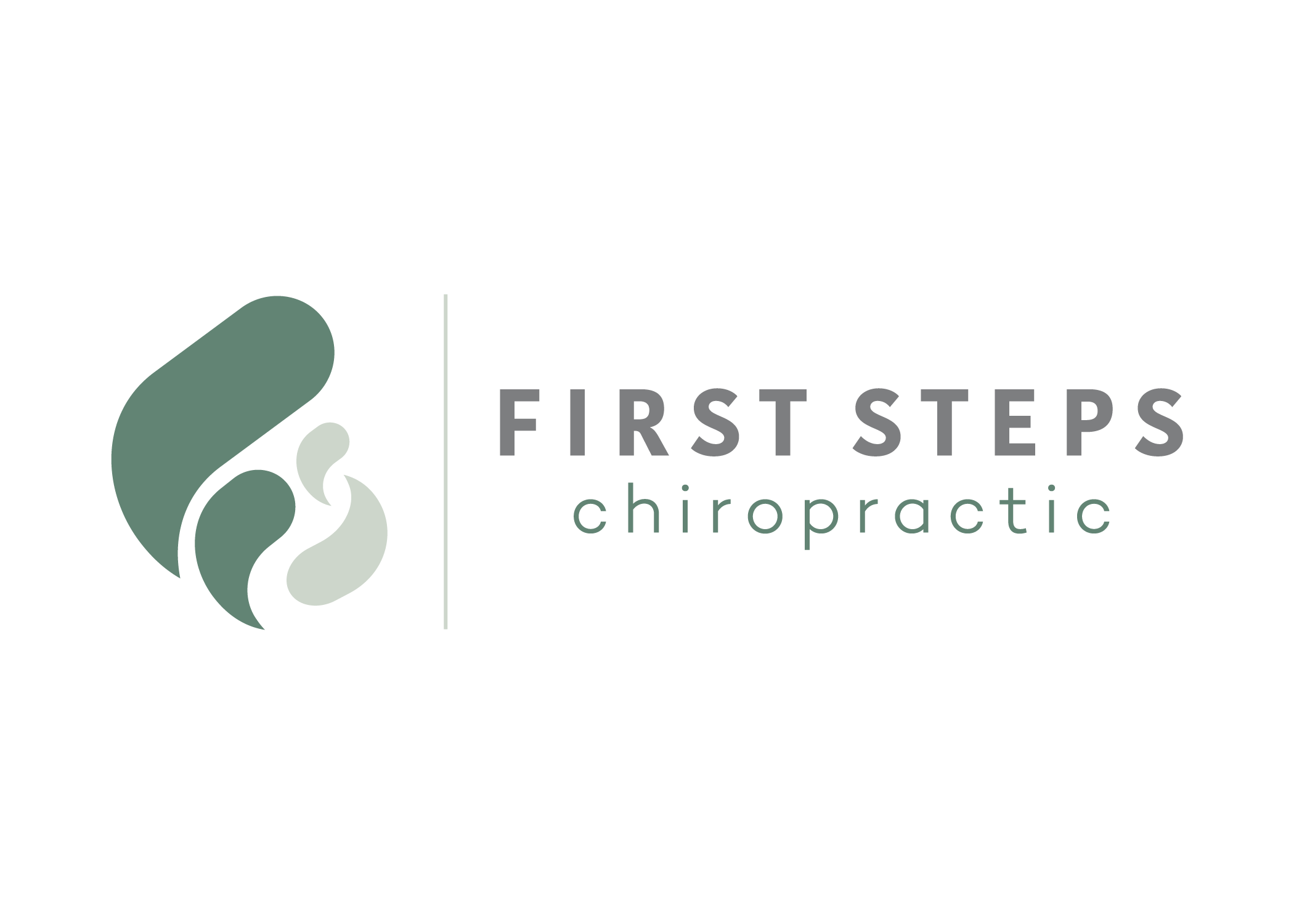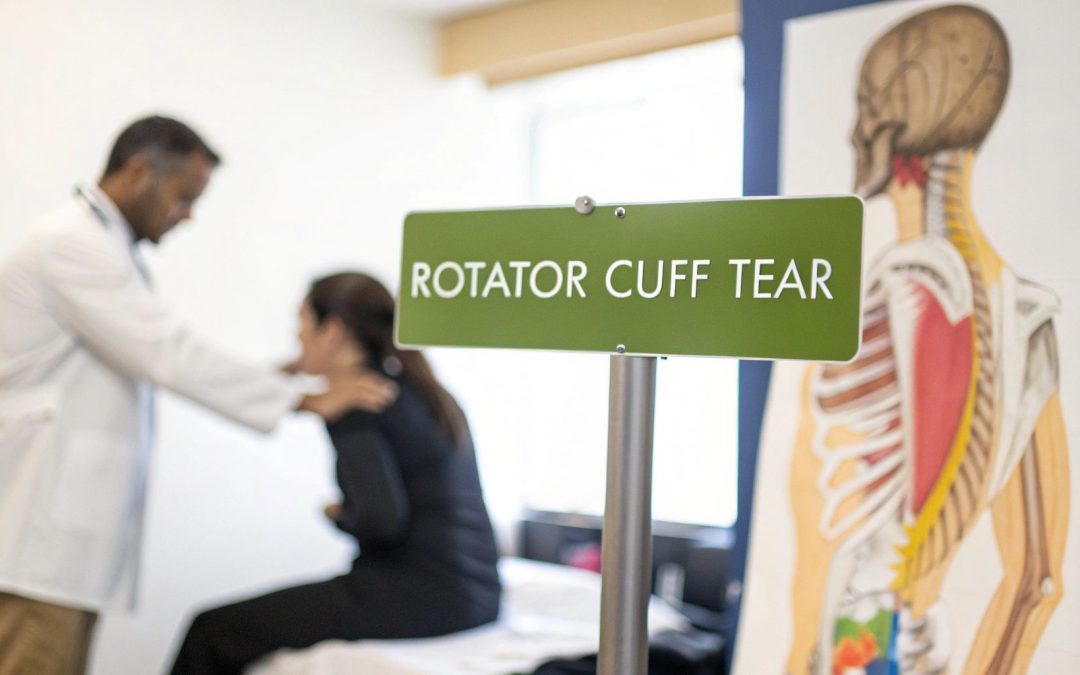Most people first notice rotator cuff symptoms as a persistent, dull ache deep inside the shoulder. This is often followed by significant pain at night that ruins a good night's sleep, or sudden weakness when trying to lift or rotate your arm. Many also find it tough to do simple things, like reaching behind their back or even just combing their hair.
What Does a Rotator Cuff Tear Feel Like?
Think of your shoulder as a sophisticated pulley system. The four strong tendons of the rotator cuff are the ropes that let your arm move freely and smoothly. When one of those ropes starts to fray—or even snaps—the whole mechanism gets thrown out of whack. That disruption is what causes the unique feelings associated with a rotator cuff tear.
It's not always a single, dramatic event. While a sudden tear from a fall can cause immediate and sharp pain, many tears develop slowly over time. This leads to symptoms you might first brush off as just soreness or a normal part of getting older.
The Most Common Warning Signs
The first step to getting the right help is recognizing the key signs. Symptoms often follow a pattern, starting as mild discomfort and eventually leading to bigger problems with how your shoulder works. Here are the most common signs you might be dealing with a tear:
- Deep, Aching Pain: This isn't a surface-level pain. People often describe it as a dull ache felt deep within the shoulder joint itself.
- Night Pain: One of the most classic signs is pain that gets much worse at night, especially if you lie on the affected shoulder. Lying down can put extra pressure on the injured tendon, making the pain flare up.
- Weakness During Movement: You might suddenly find you can't lift things you used to handle with ease. Lifting a gallon of milk, reaching for something on a high shelf, or even holding your arm out to the side can feel surprisingly difficult.
- Limited Range of Motion: Simple, everyday activities can become painful or just plain impossible. Think about fastening a seatbelt, putting on a coat, or reaching behind your back to tuck in a shirt.
- Crepitus (Popping or Cracking): Some people report hearing or feeling a crackling or popping sensation when they move their shoulder in certain ways. This sound, called crepitus, can be a sign that the damaged tendon isn't gliding smoothly in the joint.
It’s surprising just how common this injury is. Research shows that rotator cuff tears affect about 22.1% of the general population. The odds of a full-thickness tear also jump significantly with age, going from 10.7% for people in their 50s to 36.6% for those over 80. What’s truly fascinating is that the majority of these tears—a whopping 65.3%—were asymptomatic, meaning many people are walking around with tears and don't even know it.
Symptoms Breakdown By Rotator Cuff Tear Type
Not all tears feel the same. The intensity and type of symptoms you experience often depend on whether the tear is partial (the tendon is frayed) or full-thickness (the tendon has completely torn away from the bone). To get a more detailed look, you can check out our guide on rotator cuff symptoms of a tear.
A partial tear is like a rope that has started to unravel—it’s weaker, but it’s still connected. A full-thickness tear is like that same rope snapping in two, causing a complete loss of connection and function.
Knowing these differences can help you explain what's happening to your doctor or chiropractor. Here’s a table that breaks down what your symptoms might mean.
Symptoms Breakdown By Rotator Cuff Tear Type
| Symptom | Common in Partial Tears | Common in Full-Thickness Tears | Notes |
|---|---|---|---|
| Pain During Activity | Yes, especially with overhead movements. | Yes, often more constant and severe. | Pain is a primary symptom for both types. |
| Night Pain | Often present, may be moderate. | Almost always present and can be severe enough to disrupt sleep. | A hallmark symptom that usually worsens with tear severity. |
| Arm Weakness | Mild to moderate weakness, particularly when lifting. | Significant and noticeable weakness, making lifting difficult. | This is a key differentiator between tear types. |
| Loss of Motion | May have a slight loss of active range of motion. | Often a significant loss of active range of motion. | You may struggle to lift your arm on your own. |
| Popping/Cracking Sensation | Can occur occasionally. | More common and may be accompanied by pain. | Caused by the damaged tendon moving improperly over the bone. |
Ultimately, understanding whether your symptoms point to a partial or full-thickness tear is crucial for figuring out the best next steps for treatment and recovery.
Understanding Your Shoulder Anatomy
To get a handle on the tear of rotator cuff symptoms you might be feeling, we first need to look under the hood at the machine itself. Your shoulder isn't just a simple hinge; it's a complex network of bones, muscles, and tendons all working together in perfect sync. When just one part of this system gets damaged, it can throw the entire mechanism off balance, leading to that all-too-familiar pain, weakness, and frustration.
Picture your shoulder as a ball-and-socket joint. The "ball" is the very top of your upper arm bone (the humerus), which fits into a surprisingly shallow "socket" in your shoulder blade (the scapula). This design is what gives your arm that incredible range of motion—letting you throw a ball, reach for something on a high shelf, or scratch your back without a second thought.
But all that freedom comes with a trade-off. Because the socket is so shallow, the joint is naturally a bit unstable. That's where your rotator cuff comes in to save the day.
The Pit Crew for Your Arm
Think of your rotator cuff as a highly skilled pit crew for your arm. It’s not just one muscle but a team of four muscles and their connecting tendons that wrap snugly around the top of your arm bone. This group works together tirelessly to keep the "ball" of your humerus centered firmly in its "socket" during every movement.
Just like a real pit crew, each member has a specific role, but they all coordinate to ensure smooth, powerful, and stable action. Every time you lift your arm, rotate it outward, or even just hold it steady, this team is firing in a perfect sequence.
The four key muscles making up this crew are:
- Supraspinatus: This muscle is positioned right on top of the shoulder and does the heavy lifting when you raise your arm out to the side. It's the most commonly injured of the four because it often takes the brunt of the force during overhead activities.
- Infraspinatus: Found on the back of your shoulder blade, this muscle is crucial for rotating your arm outward. Simple tasks you don't even think about, like combing your hair, rely heavily on a healthy infraspinatus.
- Teres Minor: This smaller muscle is the infraspinatus's key assistant, helping with outward rotation and providing critical backup support.
- Subscapularis: Located on the front of the shoulder blade, this muscle is the powerhouse for rotating your arm inward—think of the motion you make when reaching for your wallet in a back pocket.
When a doctor talks about a "rotator cuff tear," they’re referring to a tear in one or more of the tendons that attach these four crucial muscles to your arm bone. The specific symptoms you're feeling often give us big clues as to which tendon might be injured.
Why This Anatomy Matters for Your Symptoms
Understanding this basic setup is key because it connects directly to the symptoms you're experiencing. If the supraspinatus tendon is torn, for instance, you'll likely feel a sharp pain and noticeable weakness when you try to lift your arm to the side. If the infraspinatus is the problem, reaching behind your back can become incredibly difficult and painful.
A tear compromises the entire system. The remaining healthy tendons are forced to work overtime to compensate, which leads to inflammation and that deep, dull ache you might feel even when you're resting. This new instability can also cause the joint to move improperly, creating the popping and cracking sounds known as crepitus.
By visualizing this anatomical "pit crew," it becomes much clearer why a seemingly small injury can have such a massive impact on your daily life. This foundation helps connect your specific tear of rotator cuff symptoms to what’s actually happening inside your shoulder.
The Subtle Symptoms You Might Be Ignoring
Not every rotator cuff tear announces itself with a sudden, sharp pain. More often than not, the first warnings are quiet—a gradual whisper from your body that something isn't quite right. These subtle signs are all too easy to brush off as just getting older or overdoing it a bit, but tuning into them can be the key to catching a problem before it gets serious.
Think of it like a slow leak in a tire. You might not notice it day-to-day, but over time, the performance steadily drops off. A degenerative rotator cuff tear works in much the same way, quietly chipping away at your shoulder's strength and function without a single big "aha!" moment to signal the damage.

Gradual Weakness in Daily Activities
One of the most common yet overlooked symptoms is a slow, creeping loss of strength. It’s not that you suddenly can't lift your arm. It's that tasks that used to be second nature now take a little more effort and concentration. It's easy to miss the connection to an actual injury.
You might notice this weakness when you're:
- Carrying groceries: A bag that felt fine last month now seems to really strain your shoulder.
- Lifting objects overhead: Putting a dish on a high shelf feels tougher or even causes a little twinge of pain.
- Holding your arm out: Things like blow-drying your hair or painting a wall leave your arm feeling exhausted way faster than they used to.
This happens because the injured tendon isn't pulling its weight anymore, forcing other muscles to pick up the slack. Over time, that compensation leads to fatigue and a very real decline in strength. For a deeper dive into how these signs show up, our guide on a rotator cuff symptoms tear provides more detail.
A Shrinking Range of Motion
Another sneaky sign is a gradual decrease in your shoulder's flexibility. You might not even realize you've lost motion until you try a specific movement and find yourself hitting an invisible wall. This isn't about sharp pain stopping you; it’s more like your shoulder just won't go there anymore.
Common examples include:
- Reaching behind your back: Tucking in a shirt, fastening a bra, or grabbing your wallet suddenly feels like a yoga pose you can't quite master.
- Combing your hair: Reaching the back of your head becomes an awkward, clumsy maneuver.
- Putting on a coat: The simple act of sliding your arm into a sleeve can feel stiff and strangely difficult.
This creeping loss of mobility often happens so slowly that you adapt without even thinking about it. You might start using your other arm for certain tasks or twist your body in new ways to reach things—all to unconsciously work around the stiffness in your shoulder.
The Grinding and Crackling Noises
Have you started noticing a clicking, popping, or grinding sound when you move your shoulder? This sensation, which we call crepitus, is common but frequently ignored. Since it isn't always painful, many people just write it off as a harmless quirk of aging joints.
But that noise can be a sign that the surfaces inside your shoulder joint aren't gliding smoothly anymore. When a rotator cuff tendon is damaged or frayed, it can catch or rub against the bone, creating those unsettling sounds. While it's not a definitive sign of a tear by itself, new or worsening crepitus—especially when paired with weakness or a dull ache—is a big red flag.
It's amazing how many rotator cuff issues develop without any symptoms at all. Autopsy studies have found partial tears in 28% and complete ruptures in 30% of specimens, showing just how common underlying damage can be, even in people who never reported pain. Learning to recognize these subtle symptoms is your best defense against letting a small issue grow into a major problem.
Differentiating Acute vs Chronic Tears
Not all rotator cuff tears are created equal. The story of how your injury happened—whether it was a single, dramatic event or a slow, creeping process—plays a huge role in the tear of rotator cuff symptoms you experience. Understanding the difference between an acute tear and a chronic tear is the first step toward getting to the bottom of your pain and figuring out the road to recovery.
Think of an acute tear as a sudden snap. It’s the direct result of a specific, identifiable incident. Maybe you fell hard on an outstretched arm, jerked your shoulder lifting something way too heavy, or took a direct hit during a sports game. The damage happens in an instant, and your body’s reaction is just as immediate.
A chronic tear, on the other hand, is more like a rope that has slowly frayed over many years. It doesn't happen because of one big event but is the result of gradual wear and tear. This is often called a degenerative tear because it’s linked to the natural aging process, repetitive overhead motions, or long-term stress on the shoulder joint.
The Sudden Shock of an Acute Tear
When an acute tear happens, there’s rarely any doubt that something serious has occurred. The symptoms are immediate, intense, and impossible to ignore. It’s a distinct moment you can point to on a timeline and say, "That’s when my shoulder started hurting."
Common signs of an acute tear include:
- Intense, Sudden Pain: A sharp, tearing sensation is often felt right at the moment of injury.
- A Popping Sensation: Some people report hearing or feeling an audible "pop" in their shoulder when the tendon finally gives way.
- Immediate Weakness: You might find it impossible to lift your arm. Any attempt to do so is met with severe pain and a feeling of total instability.
Because these tears are tied to trauma, they can happen to anyone at any age, regardless of how healthy the tendon was beforehand. A young athlete might suffer an acute tear from a hard tackle, while an older adult could get one from a simple fall.
The Slow Burn of a Chronic Tear
Chronic tears tell a much different, quieter story. The symptoms often sneak up on you so gradually that it’s hard to pinpoint exactly when they began. The pain might start as a mild ache you only notice after a long day, slowly getting worse over months or even years.
This slow progression is why many people with chronic tears adapt their movements to avoid pain without even realizing it. They might start using their other arm for heavy lifting or stop reaching overhead, chalking up the stiffness to just "getting older." The symptoms slowly build until they finally become disruptive enough to seek help.
A chronic tear is the result of thousands of tiny micro-traumas adding up over time. Repetitive motions from work or hobbies, combined with a natural decrease in blood supply to the tendons as we age, cause the fibers to break down and eventually tear.
This is where diagnostic imaging becomes so important. It helps professionals see inside the shoulder to confirm what's really going on, and some methods are far more effective than others.

As you can see, while an X-ray is great for ruling out bone issues, it has very low sensitivity for seeing soft tissues like tendons. That's why MRI and Ultrasound are the go-to tools for accurately diagnosing a tear.
Acute Injury vs. Chronic Degeneration Comparing Rotator Cuff Tears
To make the distinction even clearer, let’s look at the key characteristics of each tear type side-by-side. Seeing which category your symptoms fall into can provide valuable clues about the nature of your injury.
| Characteristic | Acute Rotator Cuff Tear | Chronic (Degenerative) Rotator Cuff Tear |
|---|---|---|
| Cause | Specific event like a fall, lifting a heavy object, or a sports injury. | Gradual wear and tear over time, often from repetitive motion or aging. |
| Symptom Onset | Immediate and sudden. You know the exact moment it happened. | Gradual and slow. Pain develops over weeks, months, or even years. |
| Pain Profile | Sharp, intense, and severe from the very beginning. | Starts as a dull ache, especially at night or after activity, and worsens over time. |
Knowing whether your tear is acute or chronic helps set expectations for recovery and guides the best treatment decisions. For instance, acute tears in younger, active people are often considered for surgical repair, while many chronic tears can be managed effectively with non-surgical approaches aimed at reducing pain and improving function.
How Professionals Diagnose a Rotator Cuff Tear
If you suspect you have a rotator cuff tear, getting a clear diagnosis is the critical first step toward feeling better. The process is a bit like putting a puzzle together—your doctor or chiropractor gathers clues from your personal story, a hands-on exam, and sometimes detailed imaging to see exactly what’s happening inside your shoulder.
It’s a systematic approach designed to get to the root of the problem, ruling out other issues and zeroing in on the real source of your pain. It all starts with a simple conversation. We’ll listen to how the pain started, what it feels like, and what movements make it better or worse. This initial chat gives us a roadmap for the rest of the exam.

The Hands-On Physical Examination
After we’ve talked through your symptoms, we move on to the physical exam. This is where we get hands-on, using specific tests to check your shoulder's strength, how stable it is, and its range of motion. Think of it as gently provoking the individual tendons to see if they cause pain or weakness, which gives us strong clues about which one might be injured.
We'll have you perform a few simple movements, first on your own (that’s active motion) and then with our help (passive motion). Any difference between what you can do on your own versus with assistance helps us figure out if the issue is muscle weakness or simply a stiff joint.
We often use a few classic orthopedic tests to narrow things down:
- The "Empty Can" Test: You’ll hold your arms out to the side and slightly forward, pointing your thumbs down like you’re emptying a soda can. We then apply gentle pressure as you resist. If this causes pain or weakness, it often points to a problem with the supraspinatus tendon—the most commonly torn of the four.
- The "Drop Arm" Test: We’ll lift your arm out to the side and ask you to slowly lower it. If your arm suddenly drops or you can't control the movement, it can be a red flag for a more significant, full-thickness tear.
Using Imaging to See Inside the Shoulder
While a physical exam gives us a ton of information, imaging tests are often the next step to confirm a diagnosis and understand the tear's size and severity. It’s like looking under the hood of a car to see the engine's inner workings. The type of imaging we recommend really depends on what we need to see.
A physical exam tells us that there's a problem, but imaging shows us exactly what and where the problem is. This detailed view is crucial for creating a treatment plan that’s tailored specifically for you.
The most common tools we use to evaluate a tear of rotator cuff symptoms are:
- X-rays: This is often the starting point. While X-rays don’t actually show soft tissues like tendons, they're fantastic for checking the bones. They can quickly reveal things like bone spurs or arthritis that might be causing impingement and contributing to your shoulder pain.
- Ultrasound: Using sound waves, an ultrasound creates a live picture of what's happening inside. It's a powerful, non-invasive way to see the rotator cuff tendons in action as you move your muscles, which helps us spot tears and inflammation.
- Magnetic Resonance Imaging (MRI): An MRI is really the gold standard for diagnosing rotator cuff tears. It uses a strong magnet and radio waves to create incredibly detailed, cross-sectional images of your shoulder. An MRI can show us the tear’s exact location, size, and even how old it is, giving us the most complete picture possible.
This step-by-step diagnostic process ensures we don’t miss anything. By combining your story with a thorough hands-on exam and precise imaging, we can confidently get to the root of your pain. To learn more about how our approach fits into this process, check out our information on rotator cuff treatments. This careful approach is the foundation for a targeted plan designed to get you back to living with less pain and better function.
When to See a Doctor for Shoulder Pain
Most of the time, a sore shoulder is just that—a temporary ache that gets better with a little rest and common sense. But sometimes, ignoring persistent tear of rotator cuff symptoms can turn a small problem into a much bigger one.
Knowing when to tough it out and when to seek professional help is the key to a quick recovery. It’s tempting to just "wait and see," but making the right call early on can stop a manageable issue from becoming a chronic, debilitating condition. Certain signs are your body’s way of waving a big red flag, and you don’t want to ignore them.
If your shoulder pain is the result of a sudden, traumatic event—like a car accident or a bad fall—it's always best to get it checked out right away. Don’t wait.
Clear Signs It’s Time for an Evaluation
If you’re on the fence about whether to book an appointment, look for these specific warning signs. Experiencing any of the following means it’s time to move beyond the ice pack and get a professional opinion from a chiropractor or medical doctor.
- Severe, immediate pain right after an injury.
- Hearing or feeling a "pop" or tearing sensation when the injury happened.
- You are completely unable to lift your arm on your own.
- Noticing a new bump or obvious deformity on your shoulder.
- Pain that hangs around for more than a week, even with rest.
- Shoulder pain that gets worse at night and constantly ruins your sleep.
Here's a good rule of thumb: if the pain and weakness are seriously getting in the way of your daily life—making it tough to work, get dressed, or even sleep—it's time to see a professional. Your body is sending you a clear signal that this is more than just a simple strain.
Navigating Your Healthcare Options
Once you've decided to get help, you have some great options. A neurologically-focused chiropractor is an expert in the musculoskeletal system. They can perform a detailed physical exam, figure out what’s going on with your shoulder mechanics, and offer non-invasive care designed to improve function and get you out of pain.
For more severe tears, an orthopedic specialist might be the next step. They can order advanced imaging like an MRI to get a crystal-clear picture of the injury and discuss other treatment paths if needed.
It's interesting to note that surgical interventions have become more common, especially for people between 45 and 65. In the United States, data shows a huge jump in arthroscopic surgeries over the last few decades, with rates climbing from 2–10 per 100,000 people to as high as 21–146 per 100,000. You can read the full research on rotator cuff surgery statistics to see the trends for yourself.
Understanding all your options, from chiropractic care to potential surgery, empowers you to make the best decision for your long-term health.
Common Questions About Rotator Cuff Symptoms

When you're dealing with shoulder pain, it’s natural to have a lot of questions. Let’s walk through some of the most common concerns we hear about rotator cuff symptoms and get you some clear, straightforward answers.
Can a Rotator Cuff Tear Heal on Its Own?
This is a great question, and the answer really comes down to the severity of the tear. Think of it like a rip in fabric.
A small, partial tear might improve with the right kind of care. With therapies that strengthen the surrounding muscles, your shoulder can learn to compensate for the minor injury. Rest is also a huge factor here.
But a large or complete tear is a different story. In these cases, the tendon often pulls back from the bone, much like a rubber band that has snapped completely. It simply can't reattach on its own. While we can help manage the pain and restore function, the tendon itself won't heal without surgery.
What Is the Difference Between a Tear and Impingement?
It’s easy to confuse these two since they both cause shoulder pain, but they are very different issues.
Think of shoulder impingement as a traffic jam in your shoulder joint. The tendons of the rotator cuff get pinched or crowded between the bones, leading to inflammation and that familiar ache. A rotator cuff tear, on the other hand, is more like a roadblock—it's an actual physical rip in the tendon fibers.
While chronic impingement can definitely set the stage for a tear down the line, they aren’t the same thing. The pain can feel similar, but a tear almost always brings a more noticeable weakness with it.
Does a Popping Sound Mean I Have a Tear?
Not necessarily. That popping or cracking sound—what we call crepitus—can be completely harmless. It's often just tiny gas bubbles releasing in the joint fluid or a tendon gliding over a bony prominence.
A tear can cause these noises, but that sound alone isn't a guaranteed sign of a serious injury.
If the popping is painless and you still have your full range of motion and strength, it's probably nothing to worry about. But if that pop is new, painful, and comes with a sudden feeling of weakness, that’s your cue to get it checked out.
At First Steps Chiropractic, we specialize in getting to the root cause of your shoulder pain. Our neurologically-focused approach is designed to restore proper function and bring you relief without invasive procedures. To see how we can help you on your path to recovery, schedule a complimentary consultation with us today.

